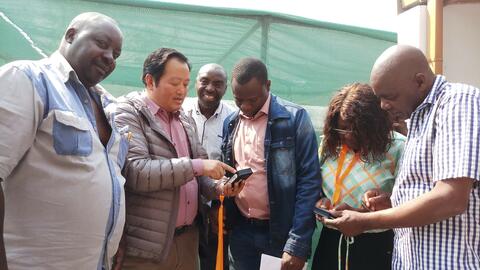GARC teams up with the OIE and Namibian government to improve rabies control activities in Namibia
In 2019, GARC provided 20 GARC Data Loggers (GDL) to the Namibian government through the ongoing Rabies Project facilitated by the World Organisation for Animal Health (OIE) and supported by Germany. This was done to overcome the limitations associated with the current paper-based data collection approach. The GDL devices will enable the vaccinators to quickly and easily record the critical vaccination information (date, time, GPS coordinates, species, age and sex) for every vaccinated animal – allowing the data to be uploaded onto the Rabies Epidemiological Bulletin (REB) for visualization and analysis. This approach will enable the campaign managers and stakeholders to track the dog vaccination campaigns as they progress throughout the target regions – ensuring that no dog populations potentially at-risk for rabies are missed.
The first step towards the routine implementation of the GDL devices within the Northern Communal Areas (NCA) of Namibia was a hands-on training session for each of the vaccinators that would be using the GDL devices during the campaign. The hands-on training, facilitated by GARC and the OIE, took place between August 5-9, 2019 at four veterinary offices located within the NCA’s Omusati, Oshana, Ohangwena and Oshikoto regions. During the training, the animal health professionals captured mock vaccination data during field simulations, ensuring that they were prepared for the upcoming campaign. Selected staff members from each of the veterinary offices were trained on the subsequent data management and the uploading of the data onto the REB.
Having completed the GDL training courses, the animal health professionals have been empowered to more quickly collect data than ever before – giving them more time to focus on reaching more dogs. Furthermore, the campaign managers will be able to monitor the progress of the campaign, direct the implementation of vaccination initiatives and overcome the limitations experienced during the first phase of the rabies control and elimination project. Data generated through the routine use of the GDLs across the NCA in the 2019 dog vaccination campaign will be published in a joint peer-reviewed publication.
Namibia’s national rabies control strategy was launched in 2015 and has been underway since 2016, with the Directorate of Veterinary Services’ efforts focussing on the vaccination of dog populations residing in the NCA of the country – an area where dog-mediated rabies is highly endemic, and people are considered to be at-risk. During the first phase of the project (2016 – 2018), an estimated 247,000 dogs were vaccinated across the NCA, and by the end of 2018 a marked decline in the number of animal and human rabies cases was observed. Through these innovative new tools and training, the next phase of the campaign will aim to reach even more animals and ensure that rabies transmission is broken, eliminating human and animal rabies cases in the area.
By continuously adapting and improving on all aspects associated with the Namibian National Rabies Control Strategy, the government has shown their ongoing dedication towards rabies elimination across the NCA. These efforts will result in freedom from dog-mediated rabies by 2030 (Zero by 30) not only being feasible but also a realistic target.
Article written by Dr Andre COETZER (GARC), Dr Tenzin TENZIN (OIE) and Dr Rauna ATHINGO (DVS, Namibia)

